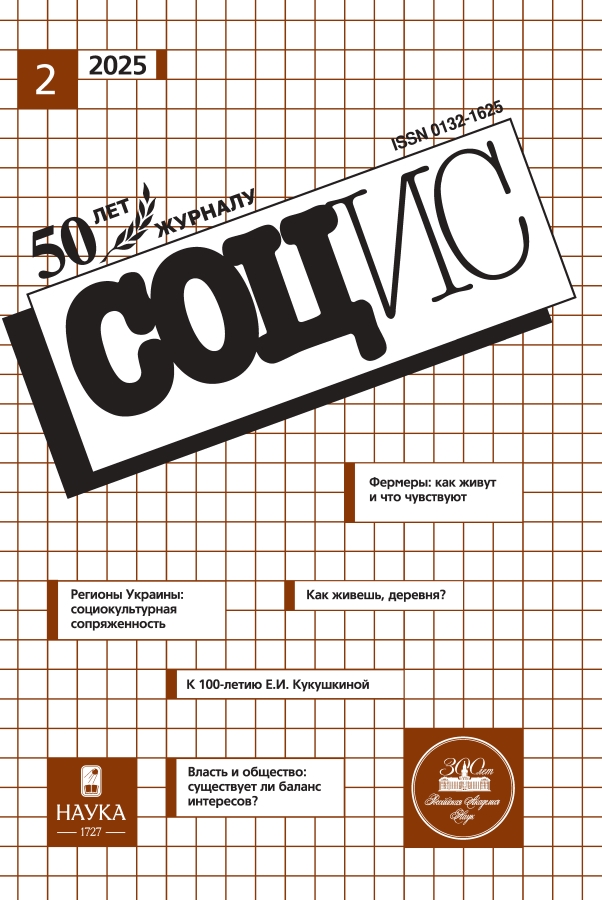Interregional cultural and historical connections and external socio-cultural orientations of Ukraine’ regions: a retrospective analysis
- Авторлар: Suschiy S.J.1
-
Мекемелер:
- Federal Research Centre the Southern Scientific Centre of the Russian Academy of Sciences
- Шығарылым: № 2 (2025)
- Беттер: 99-117
- Бөлім: HISTORY OF SOCIOLOGY
- URL: https://permmedjournal.ru/0132-1625/article/view/682089
- DOI: https://doi.org/10.31857/S0132162525020108
- ID: 682089
Дәйексөз келтіру
Аннотация
In the scientific literature, there are many options for cultural-historical zoning of Ukraine. But to what extent do regional communities themselves remain committed to their historical and cultural roots, what are their dominant interregional and external orientations? The results of a series of population surveys conducted in 2018 by the Rating sociological group in all regions of Ukraine allow to study these problematic aspects. A comprehensive analysis recorded the dominance of external cultural and historical orientations over internal ones – three-quarters of the regions primarily felt their cultural and historical affinity with neighboring states, of which Belarus, Poland, and Russia stood out. Depending on the force of attraction to them, many zones and subzones of external cultural orientation were recorded within Ukraine. The internal space of Ukraine was characterized by weak interregional cultural and historical connections, which were concentrated within a number of areas-macro-regions. The interconnections of regional communities from different areas almost always represented the mutual orientation of leading socio-cultural regions. But in general, the regions of the west and center have distanced themselves culturally and historically from the Russian-speaking southeast to a much greater extent than it has distanced itself from them. The metropolitan region did not evoke a sense of cultural closeness among most regional communities of the west and south-east and therefore did not fully cope with the function of socio-cultural consolidation of the country. More significant was the role of the Lviv region, which was targeted by the most Ukrainian-centric groups of the population throughout Ukraine.
Толық мәтін
Авторлар туралы
Sergey Suschiy
Federal Research Centre the Southern Scientific Centre of the Russian Academy of Sciences
Хат алмасуға жауапты Автор.
Email: SS7707@mail.ru
Dr. Sci. (Phil.), Chief Researcher
Ресей, Rostov-on-DonӘдебиет тізімі
- Babintsev V. P., Sapryka V. A., Bykhtin O. V., Pastyuk O. V. (2017). Interaction of Cultural and Civilization Identities of the Population of the Border Regions of Russia and Ukraine. Vestnik slavyanskih kul’tur [Bulletin of Slavic cultures]. No. 9: 9–23. (In Russ.)
- Chekalenko-Vasilyeva L. (1997) Influence of Regionalism on the Formation of Foreign Policy in Ukraine. In: Ethnic and Regional Conflicts in Eurasia. Book 2. Russia, Ukraine, Belarus. Moscow: The whole world: 179–193. (In Russ.)
- Gritsenko A. A., Krylov M. P. (2012) Ethno-Cultural Gradient: Regional Identity and Historical Memory in Neighboring Regions of Russia and Ukraine. Kul’turnaya i gumanitarnaya geografiya [Cultural and humanitarian geography]. No. 2: 126–140. (In Russ.)
- Krylov M. P., Gritsenko A. A. (2012) Regional and Ethno-Cultural Identity in the Russian-Ukrainian and Russian-Belarusian Borderlands: Historical Memory and Cultural Transformations. Labirint. ZHurnal soci-al’no-gumanitarnyh issledovanij [Labyrinth. Journal of Social and Humanitarian Studies]. No. 2: 28–42. (In Russ.)
- Kulyk V. (2022) Is Ukraine a Multiethnic Country? Slavic Review. No. 81(2): 299–323.
- Kulyk V. (2023) What Have We Learned about Ethnonational Identities in Ukraine? Nationalities Papers. No. 51(5): 975–990.
- Kutsenko О. (2023) Power of Freedom and Activism: Ukrainian Alternative to Militant Authoritarianism. XX ISA World Congress of Sociology. URL: https://sau.in.ua/app/uploads/2023/07/kutsenko_isa-congr.pdf (accessed 12.09.2023).
- Makarchuk S. A. (2012) Historical and ethnographic regions of Ukraine. Lviv: Lviv National University. (In Ukr.)
- Moshes A. (1997) Conflict Potential in Russian-Ukrainian Relations. A Look from Russia. In: Ethnic and Regional Conflicts in Eurasia. Book 2. Russia, Ukraine, Belarus. Moscow: The whole world: 23–44. (In Russ.)
- Nikiforov A. R. (2012) Cultural and Historical Analysis of the Ukrainian Political Space. Uchenye zapiski Tavricheskogo nacional’nogo universiteta [Academic notes of the Tauride National University]. No. 4: 244–253. (In Russ.)
- Portnov A. (2010) Exercises with History in Ukrainian: Results and Prospects. Moscow: OGI; Polit.ru; Memorial. (In Russ.)
- Russians in the Modern World (1998). Moscow: IEaA RAS. (In Russ.)
- Savoskul S. S. (2001) Russians of the New Abroad: the Choice of Fate. Moscow: Science. (In Russ.)
- Shulga M. A. (2010) Dynamics of the Use of Ukrainian and Russian Languages in Family Communication. Ukrainian society 1992–2010. sociological monitoring. Kiev: Azbuka: 449–458. (In Ukr.)
- Temnenko V. A. (1997) Three Ukrainians. Tavricheskie vedomosti [Tavricheskie Vedomosti]. No. 1: 27–29. (In Russ.)
- Zotova M. V., Kolosov V. A. (2018) Transformation of Cross-Border Interactions on the Russian-Ukrainian Border after 2014. Sravnitel’naya politika [Comparative Policy]. No. 2 (9): 41–61. (In Russ.)
Қосымша файлдар













